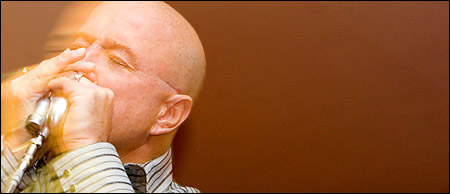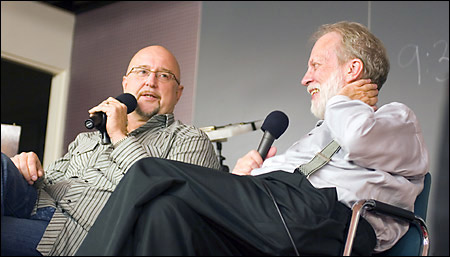Class hosts Fabulous Thunderbird
Bluesman Kim Wilson is invited to Extension School class to talk, teach, and play

What is the blues? The music can be described in terms of scales, harmonic progressions, song structure, but to really understand what the blues is, you’ve got to hear it, preferably live. It’s even better if you can get an experienced practitioner to talk about the music, how he got into it, how it makes him feel.
Video of Kim Wilson:
Real (streaming)
Quicktime (10mb download)
Members of Charles Sawyer’s Extension School course “The History of the Blues in America” had just such a lesson Oct. 18 when they were treated to a Q&A session and a performance by Kim Wilson, founder and front man of the Fabulous Thunderbirds.
Wilson, a singer and harmonica player, described how he first encountered the blues as a teenager in the 1960s, hanging out at clubs in the Los Angeles area. Masters of blues harmonica like George Smith, Eddie Taylor, and Jimmy Reed inspired him to buy an instrument and teach himself by imitating recorded performances. He was particularly captivated by the sound of George “Harmonica” Smith.
“I loved the sound that he got, that big sound. I tried to learn it off a record. I remember the first night I got it. It kind of shocked me.”
Within a year of picking up the instrument he was playing in clubs himself and receiving encouragement from his idols.
“It was an incredible thing. I wasn’t much back then. I don’t really know why those guys liked me. It must have been my enthusiasm. I know it wasn’t my talent.”

Wilson’s early success inspired him to drop out of college (“I don’t recommend that”) and to start thinking about playing music as a career. He attributes his survival to “luck and being a pest and hard work.”
Another major influence on Wilson’s playing was Little Walter, a harmonica virtuoso who often performed with Muddy Waters. Wilson loved his unique musical attack and rough, raw sound.
“If you get hooked on this stuff like I am, there’s nothing else you can do or want to do. It’s the juice of the music, that electricity thing that you can’t put your finger on, but you know when it’s there.”
That visceral, emotionally powerful quality, impossible to notate or to put into words, is what Wilson has looked for all his life, both in his own performances and in the music of others.
“When I listened to music, I wanted to be scared to death by it. I don’t think people want that anymore, they don’t want to be slapped in the face by it.”
Asked by Sawyer for his thoughts on tone, Wilson replied that for him it was purely personal and intuitive.
“It’s a physical thing. The object for me is to get as many sounds out of the instrument as I can. You just play it until it sounds right to you. It’s all about the sound, it’s not about the notes. You don’t have to be a technician to play the blues. You just have to get it across.”
Wilson emphasized that in order to capture that sound quality, you must surround yourself with the performances of the great blues masters so you will know what you are aiming for. In the days of LPs, he used to wear out the grooves in his favorite blues records, trying to absorb their elusive essence. Now he freely acknowledges the debt he owes to the mentors who inspired and taught him.
“It’s black music. They own it. I just happen to be able to do it too for some reason. Those people were like gods to me. I’ll never be able to pay them back for what they gave me.”




